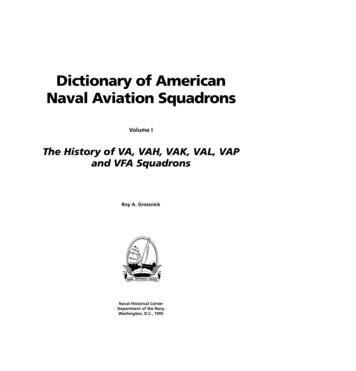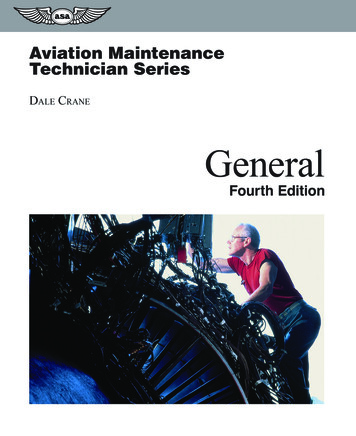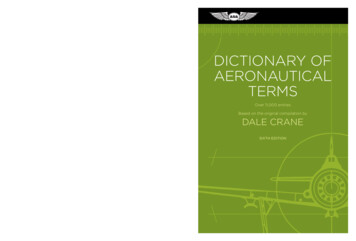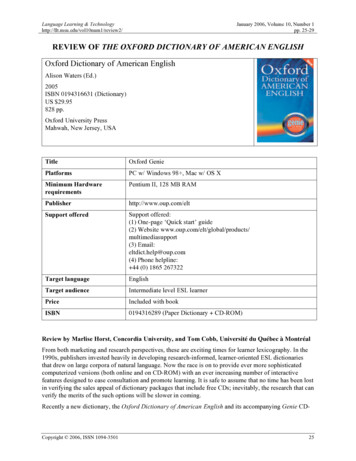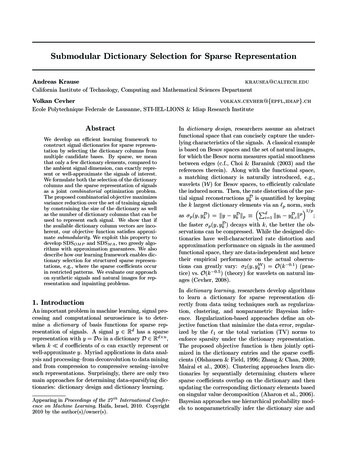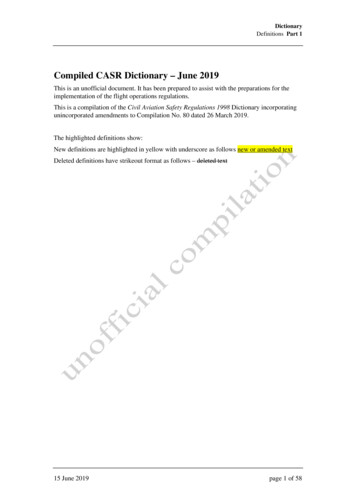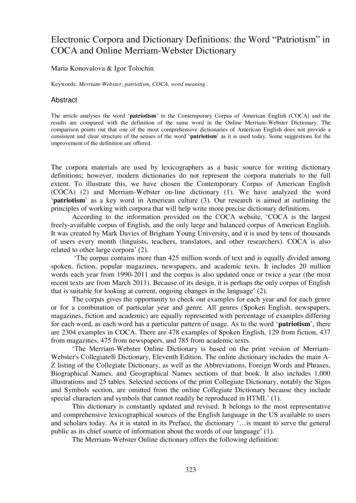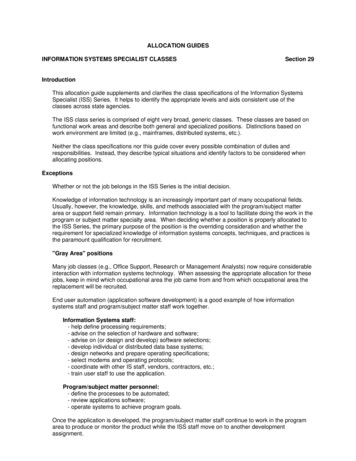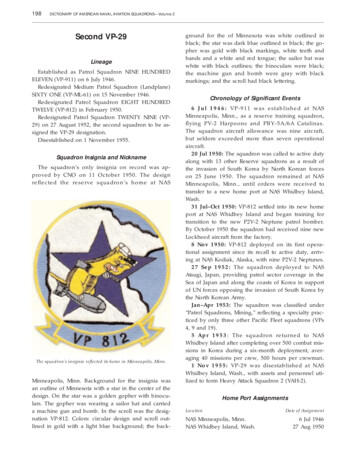
Transcription
198DICTIONARY OF AMERICAN NAVAL AVIATION SQUADRONS—Volume 2Second VP-29LineageEstablished as Patrol Squadron NINE HUNDREDELEVEN (VP-911) on 6 July 1946.Redesignated Medium Patrol Squadron (Landplane)SIXTY ONE (VP-ML-61) on 15 November 1946.Redesignated Patrol Squadron EIGHT HUNDREDTWELVE (VP-812) in February 1950.Redesignated Patrol Squadron TWENTY NINE (VP29) on 27 August 1952, the second squadron to be assigned the VP-29 designation.Disestablished on 1 November 1955.Squadron Insignia and NicknameThe squadron’s only insignia on record was approved by CNO on 11 October 1950. The designreflected the reserve squadron’s home at NASThe squadron’s insignia reflected its home in Minneapolis, Minn.Minneapolis, Minn. Background for the insignia wasan outline of Minnesota with a star in the center of thedesign. On the star was a golden gopher with binoculars. The gopher was wearing a sailor hat and carrieda machine gun and bomb. In the scroll was the designation VP-812. Colors: circular design and scroll outlined in gold with a light blue background; the back-ground for the of Minnesota was white outlined inblack; the star was dark blue outlined in black; the gopher was gold with black markings, white teeth andhands and a white and red tongue; the sailor hat waswhite with black outlines; the binoculars were black;the machine gun and bomb were gray with blackmarkings; and the scroll had black lettering.Chronology of Significant Events6 Jul 1946: VP-911 was established at NASMinneapolis, Minn., as a reserve training squadron,flying PV-2 Harpoons and PBY-5A/6A Catalinas.The squadron aircraft allowance was nine aircraft,but seldom exceeded more than seven operationalaircraft.20 Jul 1950: The squadron was called to active dutyalong with 13 other Reserve squadrons as a result ofthe invasion of South Korea by North Korean forceson 25 June 1950. The squadron remained at NASMinneapolis, Minn., until orders were received totransfer to a new home port at NAS Whidbey Island,Wash.31 Jul–Oct 1950: VP-812 settled into its new homeport at NAS Whidbey Island and began training fortransition to the new P2V-2 Neptune patrol bomber.By October 1950 the squadron had received nine newLockheed aircraft from the factory.8 Nov 1950: VP-812 deployed on its first operational assignment since its recall to active duty, arriving at NAS Kodiak, Alaska, with nine P2V-2 Neptunes.27 Sep 1952: The squadron deployed to NASAtsugi, Japan, providing patrol sector coverage in theSea of Japan and along the coasts of Korea in supportof UN forces opposing the invasion of South Korea bythe North Korean Army.Jan–Apr 1953: The squadron was classified under“Patrol Squadrons, Mining,” reflecting a specialty practiced by only three other Pacific Fleet squadrons (VPs4, 9 and 19).5 Apr 1953: The squadron returned to NASWhidbey Island after completing over 500 combat missions in Korea during a six-month deployment, averaging 40 missions per crew, 500 hours per crewman.1 Nov 1955: VP-29 was disestablished at NASWhidbey Island, Wash., with assets and personnel utilized to form Heavy Attack Squadron 2 (VAH-2).Home Port AssignmentsLocationNAS Minneapolis, Minn.NAS Whidbey Island, Wash.Date of Assignment6 Jul 194627 Aug 1950
CHAPTER 3Commanding OfficersAircraft AssignmentDate Assumed CommandUnknownLCDR F. L. MisnerCDR L. B. SmithCDR W. ArnoldCDR R. W. Lund1991946–195031 Jul 195027 Aug 1952Oct 1953Jul 1954Type of AircraftDate Type First ReceivedPV-2/PBY-5A & 9521955Major Overseas DeploymentsDate ofDepartureDate ofReturnWingBase ofOperationsType ofAircraftArea ofOperations9 Nov 195027 Sep 1952Jan 1954Apr 19552 Jun 19515 Apr 1953Apr 1954Sep acWing AssignmentsWingNARTCFAW-4Unit Awards ReceivedTail CodeAssignment DateBF6 Jul 194631 Jul 1950Unit AwardNone on record.Inclusive Date Covering Unit Award
200DICTIONARY OF AMERICAN NAVAL AVIATION SQUADRONS—Volume 2VP-30LineageEstablished as Patrol Squadron THIRTY (VP-30) on30 June 1960.Squadron Insignia and NicknameThe first insignia submitted by VP-30 was approvedby CNO on 11 August 1960. It depicted a mature crowguiding a fledgling crow in the destruction of a submarine. Colors: crows,black with orange eyesand beak; lightning bolt,orange; letters ASW,black; sea, blue; submarine, black; sky, white.Letters in the scroll atthe bottom of the design, Patrol SquadronThirty, orange. This insignia was modified inthe 1970s and the crowswere replaced by eaThe squadron’s first insignia.gles. The only change incolors involved the eagle which was white and blackwith an orange beak.A second insignia submitted by the squadron in1993 was a redesign of the modified device. The lightning bolt was nowblack, to commemoratethe incorporation of theBlack Lightnings of VP31 into VP-30 as a singlesite fleet replacementsquadron. ASW wasdeleted from the designto better reflect the multimission capability ofthe P-3C Orion aircraft.Colors: eagles, blackThe squadron’s second insignia wasbodies, yellow beaksa modification of its first design.and eyes, white headsand tail feathers; lightning, black with orange outline;sky, white; sea, blue; submarine, black. Letters in thescroll at the bottom of the design, Patrol SquadronThirty, orange.Nickname: Pro’s Nest, 1960–present.Chronology of Significant Events30 Jun 1960: VP-30 was established at NASJacksonville, Fla., under the operational control ofFAW-11. The squadron was organized to be a replacement ASW squadron, providing a continuous flow ofA squadron P2V in flight.operationally qualified pilots, aircrewmen and maintenance personnel to fleet patrol squadrons. DetachmentAlpha was established at NAS Norfolk, Va., to trainpersonnel on the P5M Marlin seaplane. The NASJacksonville unit provided training in the LockheedP2V Neptune. The squadron had an initial complement of 40 officers, 271 enlisted personnel, five P5Mseaplanes and 13 P2V aircraft (seven P2V-5FS and sixP2V-7S).15 Jul 1961: The Alpha detachment was mergedwith the parent organization at NAS Jacksonville whenplans were made to remove the P5M Marlin from theNavy’s inventory.1 Jun 1962: Det Alpha was reestablished at NASPatuxent River, Md., to begin replacement training inthe new P-3A aircraft. The unit expanded until the endof the year, by which time it was staffed with 10 officers and 53 enlisted personnel.21 Oct 1962: VP-30 transitioned from replacementtraining to an operational status for participation in thenaval quarantine of Cuba, providing ASW cover forTask Force 44. The squadron reverted to its primarymission in March 1963.10 Jan 1966: The NAS Patuxent River detachmentbecame the parent command, with the squadronheadquarters relocating from NAS Jacksonville, Fla., toNAS Patuxent River, Md. Det Alpha was relocated toJacksonville for replacement training in the SP-2ENeptune aircraft.27 May–4 Jun 1968: VP-30 was called upon to assist in the search for the missing Scorpion (SSN 589),overdue since 22 May 1968. The squadron searchedthe last known location of the vessel, 700 miles east ofNorfolk, Va., until 4 June 1968, without result.10 Dec 1968: VP-30’s Alpha detachment at NASJacksonville, Fla., was phased out with the deletion ofthe SP-2E airframes from the Navy’s inventory. The assets and personnel of the detachment were mergedwith VP-31’s Det A, home based at NAS North Island,San Diego, Calif. Personnel staffing of the former VP30 Det A was reduced from 400 to 300 with themerger. The expanded VP-31 Det A continued trainingon the P-3 Orion airframe.
CHAPTER 3Jun 1969: VP-30 received the first computerizedmodels of the P-3C.1970: With the advent of the Fleet ReadinessAviation Maintenance Training Program (FRAMP), VP30 began training maintenance as well as flight crewpersonnel, conducting ten classes a year.6 Sep 1972: AXAN Colleen A. Ocha became thefirst woman to undergo training at VP-30 in the FleetReplacement Aviation Maintenance Program (FRAMP).21 Jun 1972: The exceptional qualities of the P-3Orion aircraft were apparent when VP-30 became thefirst squadron operating the P-3 to reach the safetymilestone of 100,000 consecutive accident-free flighthours.22 Mar 1972: Lieutenant (jg) Judith A. Neufer, thesecond female Naval Aviator, reported aboard. She became the first female aviator to receive training in theP-3. Upon graduation, she reported to VW-4 at NASJacksonville, Fla.30 Jul 1975: VP-30 was relocated from NASPatuxent River, Md., to its former home base at NASJacksonville, Fla. The Navy was prompted to initiatethe move in the mid-1970s due to the increasing suburban construction around the Patuxent River airfield,electronic interference and danger of an air crash in aresidential area.2011983: VP-30 had grown to a staff of 700 personnelof all ranks, with 24 aircraft for the training of aircrewand maintenance people for service with Atlantic Fleetoperational patrol squadrons.Oct 1993: VP-30 became the sole Navy P-3 fleetreadiness squadron upon the disestablishment of VP31 on the West Coast.Jul 1995: VP-30 surpassed 31 years and 300,000flight hours of accident-free flying, a Naval Aviationrecord.Home Port AssignmentsLocationNAS Jacksonville, Fla.NAS Norfolk, Va.(Det A)NAS Patuxent River, Md.(Det A)NAS Patuxent River, Md.NAS Jacksonville, Fla.(Det A)NAS Jacksonville, Fla.A squadron P-3C flying over NAS Jacksonville, Fla., 1984.Date of Assignment30 Jun 196030 Jun 19601 Jun 196210 Jan 196610 Jan 196630 Jul 1975
202DICTIONARY OF AMERICAN NAVAL AVIATION SQUADRONS—Volume 2Commanding OfficersCommanding Officers—ContinuedDate Assumed CommandCDR L. T. Barco, Jr.CDR T. R. McClellanCDR Walter W. HonourCDR R. F. LyonsCDR B. B. SmithCDR D. E. GatelyCDR D. HowardCDR L. R. Roberts, Jr.CDR John V. JosephsonCDR J. T. CoughlinCAPT J. A. CochranCDR T. K. AnastonCDR R. B. OldsCDR R. A. MartiniCDR E. A. Wilkinson, Jr.CDR D. J. WolkensdorferCAPT F. L. WoodliefCDR R. G. CastleCDR C. S. CampbellCDR R. L. GeckCDR B. E. TobinCDR R. F. TestaCDR J. M. EvansCDR R. L. NorwoodCDR F. A. Holk, Jr.CDR D. C. HefkinCDR Richard G. Kirkland30 Jun27 Jun30 Jan25 Jan19 Dec18 Dec10 Jan21 Oct19 Jan24 Jan13 Jan26 Jan21 Jan26 Oct26 Oct10 Jan13 Apr25 Feb18 Apr18 Apr19 Dec29 Jan29 Apr20 Jul1 Nov30 Jan15 98519861988Date Assumed CommandCDR B. P. Riley IIICDR P. S. SemkoCAPT Ernest L. Morris, Jr.CAPT Paul M. GriffinCAPT Michael L. HolmesCAPT Chalker W. Brown III14 Jul31 Aug23 Aug9 Sep15 Sep22 Aug198919901991199319951997Aircraft AssignmentType of AircraftDate Type First SP-5BP-3BP-3CP-3C UIIVP-3AP-3C UII.5TP-3AP-3C UIIIP-3C 196119621962196219621965196919771978Jun 19831986May 1987Jun 1989A VP-30 P-3C(U2) at NAS Jacksonvillein April 1981 (Courtesy Rick R. BurgressCollection).Major Overseas DeploymentsDate ofDepartureDate ofReturnWingBase ofOperationsType ofAircraftArea ofOperations21 Oct 1962Mar 1963FAW-11Key WestP5M-2Carib
CHAPTER 3Wing AssignmentsWingFAW-11FAW-5 (Det A)FAW-5FAW-11 (Det A)FAW-5/PatWing-5*PatWing-11*Tail CodeLLLLLLLLLLLL203Unit Awards ReceivedAssignment Date30 Jun30 Jun10 Jan10 JanJun30 Jul196019601966196619721975FAW-5 was redesignated COMPATWINGSLANT and Patrol Wing 5(PatWing-5) on 1 July 1973. It remained a dual hatted commanduntil 1 July 1974 when Patrol Wing 5 became a separate command.Unit AwardAFEMMUCSLOCA squadron P-3C flying over Jacksonville, Fla., 1993.Inclusive Date Covering Unit Award24 Oct1 Jan1 Dec1 Jan1 OctMar19621969198019891991197831 Dec31 Dec30 Jun1 Jul1 JunJul196219691982199019931978
204DICTIONARY OF AMERICAN NAVAL AVIATION SQUADRONS—Volume 2Second VP-31LineageEstablished as Patrol Squadron THIRTY ONE (VP31) on 30 June 1960, the second squadron to be assigned the VP-31 designation.Disestablished on 1 November 1993.Squadron Insignia and NicknameThe only insignia for VP-31 was approved by CNOon 25 July 1962, and was selected to represent theASW training program used to educate patrolThe squadron’s one and only insignia.squadron personnel for assignment in the fleet. Thecentral figure of the design was a submarine at thefocal point of four beams from on high. Above thesubmarine was a magic lamp from which issued awisp of smoke. The lamp signified the squadron’soriginal nickname, the Genies. The design was circular, with a scroll at the bottom containing the designation Patrol Squadron Thirty One. Colors: outline of design, lamp and beams, silver and gold; lamp andsubmarine trim, red; central portion of beams, cream;background of design and submarine, deep blue.Nickname: Genies, 1962–1971.Black Lightnings, 1971–1993.Chronology of Significant Events30 Jun 1960: VP-31 was established at NAS NorthIsland, San Diego, Calif., under the operational controlA squadron P2V, note the insignia just below the cockpit.of FAW-14. The primary mission of the squadron wastraining replacement aircrew and maintenance personnel for all Pacific Fleet patrol squadrons, administrative control of the sonobuoy buildup shop and allclass D maintenance for all patrol squadrons on NorthIsland. Limited training was begun soon after thesquadron’s establishment, but it was not until the fallof 1960 that a complete staff of 20 officers and 300enlisted personnel were engaged in full-scale trainingoperations with an inventory of two LockheedNeptune P2V-5FS aircraft, two P2V-7s, and oneDouglas Skymaster R-5D.Nov 1961: The squadron’s responsibilities were expanded to include training foreign personnel transitioning to the P2V-7. Seventy-two members of theRoyal Australian Air Force’s Maritime ReconnaissanceSquadron 10 were among the first foreign students tobe assigned for training in this aircraft. Two GrummanUF-1/SHU-16B Albatross seaplanes were assigned toVP-31 and converted to ASW specifications for trainingair force personnel from Norway, Chile, Colombia,Peru, and Spain.4 Jan 1963: VP-31 Det Alpha was established atNAS Moffett Field, Calif. Its primary mission was totrain pilots and aircrewmen for the advanced ASW aircraft, the Lockheed P-3 Orion. The squadron’s P-3 aircraft averaged 8,600 flying hours a year in trainingmissions.8 Jan 1966: VP-31 Detachment Alpha moved fromHangar Three into historic Hangar One aboard NASMoffett Field. Hangar One, now a Naval Memorial site,was built in April 1933 as a home for the Navy’slargest dirigibles, Macon (ZRS-5) her sister ship, Akron(ZRS-4). The vast 10,000 square foot structure provided much needed space for the constantly expanding operations of the squadron.1 Jul 1966: Det Alpha at NAS Moffett Field, Calif.,was renamed Detachment Moffett. The parent squadronremained at NAS North Island, San Diego, Calif.
CHAPTER 3205The squadron flew UF-1s (HU-16s) for a short time in the early 1960s.A squadron R7V-1 at NAS North Island, June 1962 (Courtesy WilliamL. Swisher Collection).A squadron P5M being retrieved from the water by thebeach crew, 1962.1 Jan 1967: Detachment Moffett became the parentelement of VP-31, and the unit at North Island becameDetachment North Island. This changed occurred toaccommodate the increasing numbers of students receiving training on the P-3 airframe. DetachmentNorth Island discontinued training on the Martin P-5Marlin when the Navy ceased seaplane operations in1967, but continued to provide training to crews onthe P-2 Neptunes until its disestablishment in 1970.6 Mar 1969: All six crewmembers of the squadron’sP-3A, BuNo. 152765, RP-07 died when it crashed atNAS Lemoore, Calif., at the end of a practice groundcontrol approach (GCA) landing.
206DICTIONARY OF AMERICAN NAVAL AVIATION SQUADRONS—Volume 21 Jan 1970: VP-31’s Detachment North Island wasdisestablished, having trained over 2,000 pilots, 700Naval Flight Officers, and 10,600 aircrewmen/maintenance personnel.7 Jul 1971: The Black Lightnings received CNO approval for the P-3A/B Fleet Replacement AviationMaintenance Program (FRAMP), designed to train aircrew and ground personnel in the transition fromolder model P-3 Orions to the newer versions.26 May 1972: A VP-31 P-3A, BuNo. 152155, failedto return to NAS Moffett Field at the completion of aroutine training flight. Search operations by Navy,Army, Air Force and Civil Air Patrol aircraft continuedfor seven days, but no trace of the missing aircraft wasever found. Two crewmen, three personnel under instruction and three observers were listed as missingand presumed dead.Jun 1974: VP-31 was tasked with training Iraniannavy aircrews on the specially configured version ofthe Orion, the P-3F, that would be used by that country’s military for maritime patrol. Flight training/familiarization was completed in December, with all aspectsof the support/maintenance training syllabus completed by 6 June 1975.Jan 1984: VP-31 began the transition of Pacific Fleetpatrol squadrons to the P-3 aircraft with enhancedavionics configurations. In one 15-month period, thesquadron received 22 aircraft for extensive avionicsmodifications. In the years following, VP-31 averaged16 to 18 Orion modifications every 12 months.1 Nov 1993: VP-31 was disestablished due to theclosure of NAS Moffett Field and the consolidation oftraining resources into one VP training squadron, VP30, based at NAS Jacksonville, Fla.Home Port AssignmentsLocationNAS North Island, Calif.NAS Moffet Field, Calif.(Det Alpha)(Det Moffet)NAS Moffett Field, Calif.Two squadron P-3s in flight.Date of Assignment30 Jun 19604 Jan 19631 Jul 19661 Jan 1967
CHAPTER 3Commanding OfficersCommanding Officers—ContinuedDate Assumed DRCDRCDRCDRCDRCDRCDRCDRCDRCDRCDRJohn W. MurphFillmore G. Koenig, Jr.Grant L. DonnellyE. E. Pierre, Jr.H. K. Cooley, Jr.P. J. Hartley, Jr.George P. PrassinosMarvin D. MarshRoy D. Snyder, Jr.Karl J. BernsteinRichard S. ZeiselRalph R. HedgesD. B. PittsG. S. PhillipsEdwin K. AndersonGerald W. MackayRichard F. GreenHarold L. MidtvedtJohn SiembiedaRobert M. HowardKenneth D. SullivanClyde T. Moyer IIIEdward R. EnterlineMichael D. HaskinsJohn R. Ryan20730 Jun10 Apr29 JunOct22 Jul15 SepMar30 Mar17 Apr27 May15 Jul8 Jul28 Jul17 Aug2 AugNov24 Nov23 Nov23 Feb14 May24 Jul20 Oct27 Jan21 Jun18 986Date Assumed CommandCDR Raymond J. MorrisCDR William G. BozinCDR Ralph M. AlfordCDR David C. HullCAPT Gregory A. Markwell12 Jun15 Jul21 Jul20 Jul2 Aug19871988198919901991Aircraft AssignmentType of 54SR7V-1C-121JUF-1/SHU-16BP-3AP-3BP-3CP-3FP-3C UIVP-3AP-3C UIIP-3C UII.5P-3C UIIITP-3ADate Type First 6019601960196119611961196319651970197419751977Dec 19771983Jan 19851986An R5D transport with the tail code RP. However, this is not an R5D that was assigned to VP-31. The photo is from 1952 and the aircraft was assigned to VR-1. VP-31 was assigned the tail code RP in 1960 and received an R5D in July 1960.
208DICTIONARY OF AMERICAN NAVAL AVIATION SQUADRONS—Volume 2Three squadron P-3s.Major Overseas DeploymentsDate ofDepartureDate ofReturnBase ofOperationsWingType ofAircraftArea ofOperationsNone.Wing AssignmentsWingTail CodeFAW-14FAW-10 (Det Alpha)FAW-10 (Det Moffett)FAW-10 (Det North Island)COMPATWINGSPACPatWing-10Two squadron P-3s flying overthe Golden Gate bridge.RPRPRPRPRPRPUnit Awards ReceivedAssignment Date30 Jun4 Jan1 Jul1 Jan30 Jun1 Jun196019631966196719731981Unit AwardMUCSLOCInclusive Date Covering Unit Award1 Jun 19711 Sep 19811 Nov 198820 Jul 19711 Sep 19821 Dec 1989
CHAPTER 3Third VP-32LineageEstablished as Patrol Squadron SIXTY TWO (VP-62)on 6 September 1943.Redesignated Patrol Bombing Squadron SIXTY TWO(VPB-62) on 1 October 1944.Redesignated Patrol Squadron SIXTY TWO (VP-62)on 15 May 1946.Redesignated Amphibian Patrol Squadron TWO (VPAM-2) on 15 November 1946.Redesignated Patrol Squadron THIRTY TWO (VP32) on 1 September 1948, the third squadron to be assigned the VP-32 designation.Disestablished on 6 June 1949.Squadron Insignia and NicknameThe only known insignia for this squadron was approved by CNO on 9 August 1944. Its central characterwas an aggressive, gray, winged cat in keeping withthe squadron’s aircraft (the Catalina) and the “searchand destroy” nature of the squadron’s mission. Thebomb and binoculars gripped in the cat’s pawssignified the employment of the squadron as a patrolThe squadron’s insignia, approved during World War II.209bomber unit. Colors: background, royal blue; cat, steelgray outlined in black; wings, yellow; jowls, white;whiskers, black; teeth, white; eyeball, white with blackpupil; bomb, yellow with gray tail; binoculars, steelgray. This insignia was used after each redesignationof the squadron from VP-62 through VP-AM-2. Thereis no indication that it was used after the squadronwas redesignated VP-32.Nicknames: None on record.Chronology of Significant Events6 Sep 1943: VP-62 was established at NAS WhidbeyIsland, Wash., under the operational control of FAW-6.Like the previous VP-62 disestablished in July 1943,the squadron was designated as an amphibioussquadron flying the PBY-5A Catalina. The squadron remained at Whidbey Island through November andconducted training ashore.25 Nov 1943: VP-62 departed NAS Whidbey Island,Wash., for Dutch Harbor, Aleutians, headquarters ofFAW-4, arriving on 30 November. The squadron received its assignment and departed for NS Adak,Alaska, the next day.10 Dec 1943: VP-62 was temporarily based ashoreat Amchitka, Alaska, for familiarization flights.31 Jan 1944: VP-62 flew to Attu, following theArmy’s recapture of the island on 29 May 1943. Thelast island in the Aleutian chain, Attu was the jumpingoff point for bombing missions over the Kuriles. Thesquadron flew no bombing missions but conducted reconnaissance of the waters surrounding Attu.22 Mar 1944: Several VP-62 crews were sent to theLORAN (long-range navigation equipment) school atAdak, Alaska. First tested in June 1942, LORAN servedas a homing device that gave the navigator or pilot asignal that varied if the aircraft moved away from thecenter of the beam. With up to 60 percent of all theflying in the Aleutians conducted in instrument flightrule (IRF) conditions, LORAN saved many aircrewsthat would otherwise have been unable to find theirbases due to overcast down to ground level.12 Oct 1944: VPB-62 was relieved by VPB-43 forreturn to NAS Seattle, Wash. All 12 aircraft and associated ground crew personnel returned to NAS Seattle,Wash. On 10 November 1944, all hands were given orders and home leave.1 Dec 1944: VPB-62 was reformed at NAS WhidbeyIsland, Wash., under the operational control of FAW-6.Training was conducted for long range patrol andbombing.1 Jan–Jun 1945: The squadron was relocated toNAS Oak Harbor, Wash., for continuation of training,which was completed by the end of June 1945.1 Jul–Aug 1945: VPB-62 flew to NAS WhidbeyIsland in preparation for deploying to the Aleutians.Eleven of the crews departed on 15 July. One aircraft
210DICTIONARY OF AMERICAN NAVAL AVIATION SQUADRONS—Volume 2undergoing maintenance at Whidbey Island was leftbehind; this plane’s crew departed on a Naval AirTransport Service (NATS) flight to Adak, Alaska, on 25August. The ground support staff departed Seattleaboard SS Henry Failing, arriving at Adak on 13August. After reporting to FAW-4 headquarters atKodiak, the squadron was deployed in four detachments: headquarters at Adak, Det 2 at Amchitka, Det 3at Dutch Harbor, and Det 6 at Kodiak. The duties ofthe detachments were to conduct sector searchesalong the Aleutian chain.4 Sep 1945: Det 2 at Amchitka, Alaska, was absorbed into the headquarters group on Adak.27–28 Sep 1945: Det 3 at Dutch Harbor, Alaska,was withdrawn to Kodiak.Sep 1945: A PBY-5A piloted by VPB-62’s commanding officer Commander George R. Smith, which tookoff from Cold Bay, Alaska, carrying a full crew andnine passengers, crashed at the foot of Old Woman’sMountain. Eight of the 15 people aboard were killed.Jan 1946: VPB-62 was stationed at NAS WhidbeyIsland, Wash., with a complement of 14 PBY-6ACatalinas.15 May 1946: VPB-62 was redesignated VP-62, andthe aircraft complement was reduced to nine PBY-6ACatalinas. A detachment of four aircraft was deployedto NS Adak, Alaska.15 Nov 1946: VP-62 was redesignated VP-AM-2 andthe squadron’s complement of aircraft was reducedagain, from nine to six PBY-6A Catalinas. A detachmentof four aircraft was still deployed to NS Adak, Alaska.The number of PBY squadrons in the Navy was beinggreatly reduced, with existing stocks of newer PBY-6Aaircraft going to the Navy Reserve amphibioussquadrons which were established on 1 May 1946. Theactive duty amphibious squadrons were being converted to the P2V Neptune and P4Y-2 Privateer.Jun 1947: The squadron had only three PBY-5A aircraft at NAS Whidbey Island, Wash., compared to thesix PBY-6As they were authorized on the allowancelist.Sep 1947: The three remaining squadron aircraftdeployed to NS Adak, Alaska. VP-AM-2 was still anoperational squadron but was not assigned its full inventory of aircraft and personnel due to the postwarcutbacks.15 Jan 1948: VP-AM-2 was en route to NASKaneohe, Hawaii, with its three PBY-5A Catalinas for apermanent change of station. By April 1948, thesquadron was at Kaneohe with a full complement ofsix PBY-6A Catalinas, apparently issued upon arrivalfrom postwar stocks. By June, the squadron allowancehad been increased to nine PBY-6As.1 Sep 1948: VP-AM-2 was redesignated VP-32. ByDecember 1948, the squadron was equipped with twoPBN-5As and seven PBY-6A Catalinas.Feb–Apr 1949: By January 1949, the Navy had decided to eliminate a number of the active dutysquadrons flying the medium seaplanes. By Februarythe squadron’s inventory of aircraft had been reducedto seven. By the end of April there was only one PBY6A left on hand.6 Jun 1949: VP-32 was disestablished at NASKaneohe, Hawaii.Home Port AssignmentsLocationNASNASNASNASNASNASDate of AssignmentWhidbey Island, Wash.Seattle, Wash.Whidbey Island, Wash.Oak Harbor, Wash.Whidbey Island, Wash.Kaneohe, Hawaii6 Sep12 Oct1 Dec1 Jan1 Jul15 JanCommanding OfficersDate Assumed CommandLCDR F. R. MooreLCDR George R. SmithLCDR W. H. WithrowLCDR H. E. SurfaceLCDR R. U. NolenCDR J. H. Arnold6 Sep1 Dec3 Oct17 Aug31 DecDecDate ofReturn25311313*Nov 1943Jan 1944Aug 1945†Aug 1945†12 Oct 1944Oct 1945Oct 1945194319441945194619471948Aircraft AssignmentType of AircraftDate Type First ReceivedPBY-5APBY-6APBN-5ASep 1943Jan 1946Sep 1948Major Overseas DeploymentsDate ofDeparture194319441944194519451948WingBase ofOperationsType ofAircraftArea PBY-5APBY-5APBY-5APBY-5ANorPacNorPacNorPacNorPac
CHAPTER 3211Major Overseas Deployments—ContinuedDate ofDepartureDate ofReturnWingBase ofOperationsType ofAircraftArea ofOperations13 Aug 1945†13 Aug 1945†15 May 1946Sep 1946Oct 1945Oct 1945Jun 1946Feb 1947FAW-4FAW-4FAW-4FAW-4Dutch acNorPacNorPacNorPac*†Continued combat deployment in the North Pacific, moving from base to base.The squadron conducted split deployment to two or more sites on the same dates.Wing Tail CodeDB§DBUnit Awards ReceivedAssignment Date6 Sep25 Nov12 Oct15 JulOct15 May15 Jan1943194319441945194519461948§ The squadron remained a part of FAW-4, but was assigned the tailcode DB on 7 November 1946.Unit AwardNone on record.Inclusive Date Covering Unit Award
212DICTIONARY OF AMERICAN NAVAL AVIATION SQUADRONS—Volume 2Third VP-33LineageEstablished as Patrol Squadron TWELVE-F (VP-12F)on 1 November 1935.Redesignated Patrol Squadron TWELVE (VP-12) on 1October 1937.Redesignated Patrol Squadron FIFTY ONE (VP-51)on 1 July 1939.Redesignated Patrol Squadron SEVENTY ONE (VP71) on 1 July 1941.Redesignated Patrol Bombing Squadron SEVENTYONE (VPB-71) on 1 October 1944.Redesignated Patrol Squadron SEVENTY ONE (VP71) on 15 May 1946.Redesignated Amphibian Patrol Squadron THREE(VP-AM-3) on 15 November 1946.Redesignated Patrol Squadron THIRTY THREE (VP33) on 1 September 1948, the third squadron to be assigned the VP-33 designation.Disestablished on 15 December 1949.area of the squadron during that period. Mt. Rainierwas prominent in the background of the design, andwas always the landmark for patrols returning overthe fog from seaward. The foreground of the designfeatures a thunderbird surmounting a totem pole.The Indians regarded the thunderbird as abeneficent spirit that when angered turned its headfrom side to side with fire darting from its eyes. Inthe design the fire was represented by lightning. Thelegendary battles between the thunderbird (patrolaircraft) and the whale (submarines) were analogousto patrol plane operations. Colors: sky, blue; lightning, yellow; snow cap of mountain, white; base ofmountain, green; totem pole and thunderbird, a variety of colors.Squadron Insignia and NicknameThe first insignia of the squadron was designed in1937. It was symbolic of the northwestern UnitedStates and Alaska, the squadron’s normal operatingThe squadron’s first insignia was designed onits area of operations.This insignia is a modification of the first insignia with the squadron’s designation VP-71added at the bottom.The squadron’s second insignia was used during its operations as aBlack Cat squadron.The second insignia of the squadron was adoptedwhen VPB-71 was operating in the South Pacific as aBlack Cat squadron. The cat chosen by the squadronwas a tough-looking customer all in black, wearing aflotation vest, seaman’s cap, cigar stub in mouth, holding a smoking Colt .45 in both paws. Colors: cat, blackwith white muzzle and yellow eyes; seaman’s cap,white; flotation vest, yellow; Colt .45, gray.The squadron’s third insignia was approved on 9August 1948, shortly before it was redesignated VP-33.This insignia depicte
198 DICTIONARY OF AMERICAN NAVAL AVIATION SQUADRONS—Volume 2 The squadron's insignia reflected its home in Minneapolis, Minn. Minneapolis, Minn. Background for the insignia was an outline of Minnesota with a star in the center of the design. On the star was a golden gopher with binocu-lars. The gopher was wearing a sailor hat and carried
